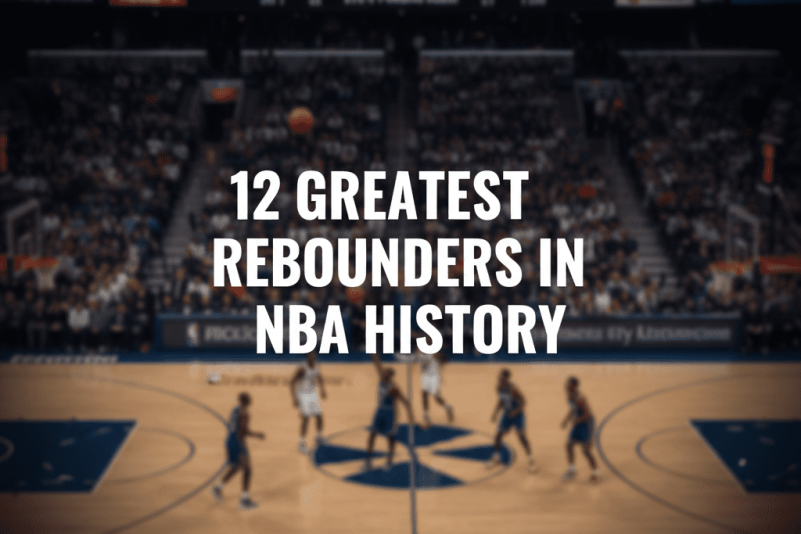
If you care about the noise under the rim more than the TV graphic, this is for you. The greatest rebounders in NBA history are not just tall people in good situations. They are technicians. They study angles, carve space with their hips, read spin in the air, and live with contact that would send most of us into retirement.
For this list, we look at big numbers, big games, and repeatable craft. Not just one loud season. These are the players who controlled possessions, controlled series, and in more than a few springs, controlled how the sport itself felt.
In plain words: this is about the players who turned rebounding into a science and a weapon.
Table of Contents
- Why Rebounding Still Decides Seasons
- Methodology And Criteria
- The Players Who Owned The Glass
- What Comes Next
Why Rebounding Still Decides Seasons
Modern spacing did not erase the value of the glass. It just punished teams that do not understand it. Every extra board is another possession for a pull up three, another chance to drag a defense into rotation, another moment to slow a run and breathe.
Rebounding is also the one place where effort, timing, and pain tolerance still beat raw skill. It exposes who wants contact and who wants numbers. You watch enough playoff series and you see the same thing. The team that finishes possessions clean usually walks out of the arena with the season still alive.
So when we talk about the greatest rebounders in NBA history, we are really talking about players who controlled pressure. Their techniques work in any era, even inside today’s pace and space chaos.
Methodology And Criteria
Rankings are based on official NBA and Basketball Reference leaderboards, rebounding titles, rebound percentages, playoff impact, offensive and defensive balance, portability across eras, and documented technique, with close calls broken by two way impact and longevity.
The Players Who Owned The Glass
1. Wilt Chamberlain Greatest Rebounders in NBA History
Start with the night in 1960 when Wilt Chamberlain pulled down 55 rebounds against Bill Russell. That game lives in grainy photos and box scores, but it tells the story. He did not just stand tall. He attacked the ball at its highest point, palmed it, and snapped it out like it belonged to him.
For his career, Wilt averaged 22.9 rebounds with 23,924 total, still first all time. In a modern lens, that looks unreal. No current player flirts with even 15 a night for a season, never mind that as a career. His volume sits in a different galaxy, even after you adjust for pace and miss heavy offense.
Billy Cunningham once said the record book read like Wilt’s personal diary. That fits. The technique behind it was simple to describe and brutal to survive: early seal, violent swim of the arms, and the confidence to grab with one hand when others were tapping with two. Stories from teammates say he treated rebound drills like competition sprints, not loose reps. That edge, and the way crowds buzzed when a shot went up near him, still hangs over how we imagine dominance on the glass.
2. Bill Russell Greatest Rebounders in NBA History
Picture a deciding game in Boston. Green banners, bad lighting, Russell reading the shot before it leaves the hand. He was not chasing numbers. He was ending possessions and starting breaks in one motion. That is the defining scene.
Russell finished with 21,620 rebounds at 22.5 per game, plus the heaviest playoff rebounding resume anyone has ever built. He owned the glass for a dynasty that won 11 titles, and he did it in ways that still translate: boxing out his own man then sliding into someone else’s lane, tipping to space when a clean grab was not safe, steering misses to guards streaking out.
He framed it in team terms. He talked about presence, habits, and making opponents think he could block every shot. That same mind shaped his rebounding. Teammates recall him calling out where a ball would land. The culture impact is obvious. He turned rebounding into a leadership job, not just a tall guy duty, and every serious big since has stolen a piece of that blueprint.
3. Dennis Rodman Greatest Rebounders in NBA History
Here is the thing about Rodman. The numbers are wild, but the work is wilder. In the 90s he strung together seven straight rebounding titles, living around 16 to 18 boards a night while taking almost no shots.
Rodman attacked the glass with a scientist’s brain and a stuntman’s body. He studied film just to track how different shooters missed. He drilled with friends firing from corners so he could learn spin and trajectories. One of his lines sums it up: every rebound was a personal challenge. That is not stat padding. That is obsession.
You feel it in how fans talk about him. The hair, the chaos, sure, but under that, respect for a player who treated a role job like stardom. His success made rebounding cool again for undersized forwards and sent a message you still see in locker rooms: if one player is willing to do all the dirty work, the rest have no excuse.
4. Moses Malone Greatest Rebounders in NBA History
Flash to the 1983 run. Missed jumper, Moses crashes, one putback, another, game over. That is the Moses reel in short form. He did not wait for the ball. He hunted it before anyone else realized it was short.
Moses retired with 16,212 rebounds and owns the all time offensive rebounds record by a huge gap, with 6,731 on the NBA books. In an era where most modern teams send players back in transition, nobody gets close to that level of second chance pressure.
He said it best once: they were not paying him to pass. That blunt line fits the stories, from teammates talking about his conditioning runs to coaches laughing at how often he would rebound his own miss. The cultural piece is simple. Moses turned the offensive board into a swing of momentum, and every coach teaching young bigs to follow their shot is, in some way, copying him.
5. Kareem Abdul Jabbar Positional Control
The defining image of Kareem on the glass is not a scramble. It is calm. Long arms, early position, one step to the ball. In game after game for Milwaukee and Los Angeles, he turned rebounds into controlled outlets and that skyhook on the other end.
Kareem sits third in total rebounds with 17,440, built over 20 seasons without chasing. His defensive rebound numbers, especially in the mid 70s, belong with any specialist, and he did it while carrying one of the largest scoring loads in league history.
He talked often about conditioning and craft. About needing routines to last. That discipline shows in his glass work. No wild leaps, just angles, box outs, and timing that let him beat heavier players. The lesson for modern bigs is clear. You can be a primary scorer and still treat rebounding as non negotiable.
6. Tim Duncan Box Out Masterclass
If you watch peak San Antonio tape, watch Duncan when the shot goes up. Head turn, find body, forearm across the hip, seal, then a simple grab. It is so clean most viewers forget it is why everyone else looks free.
Duncan finished with 15,091 rebounds, good for the upper tier on the all time list, while anchoring elite defenses for almost two decades. His playoff rebounding, especially deep in runs, stacks up with the specialist greats when you adjust for pace.
Duncan rarely gave big speeches, but teammates and coaches framed him as the standard for fundamentals. His glass work became teaching tape. Young bigs still learn how to reverse pivot into box outs because he did it. That quiet control changed games without needing any noise.
7. Hakeem Olajuwon Elastic Footwork On Glass
Think about Hakeem in traffic. Miss goes up, and he slides, not crashes. One quick step, twist of the shoulders, long arms pulling the ball where nobody else can reach. The same footwork that sold the Dream Shake let him win space in crowded paints.
He grabbed 13,747 rebounds with two league rebounding titles, while also finishing as the all time leader in blocks at retirement. That balance of rim protection and board work puts him in a rare category. In a modern sense, he is the model for bigs who must switch, protect, and still clean the glass.
Olajuwon often credited his soccer background and talked about dedication, not just talent. That mindset shows up in film sessions and summer stories, where younger centers flew in just to learn his footwork. His impact lives in every modern big man trainer preaching active feet instead of standing tall and reaching.
8. Shaquille ONeal Power And Space
Some rebounds never had a chance to be contested. With Shaq, the technique started before the shot. Deep seal, shove of space, then a board that felt like a statement. You could see opponents decide it was not worth the fight.
Shaq pulled 13,099 rebounds while taking more hits than almost any center of his time, and his best years in Los Angeles and Orlando come out elite even when you adjust for tempo. His presence alone tilted opponent shot charts away from the paint, which only increased the value of the ones he did grab.
He liked to remind people he was the most dominant. On the glass, that tracks. Teammates talk about practices where the only rule was to survive his box out. The cultural imprint is big man as force of nature, and every young center who thinks strength alone is enough is really chasing Shaq’s standard, whether they know it or not.
9. Charles Barkley Relentless Undersized Force
First memory for many is Barkley flying in from the wing, elbows everywhere, ripping a rebound over taller centers and pushing coast to coast. At around 6 foot 4 or 6 foot 5 in a league of giants, he treated every miss like proof that height can lie.
Barkley averaged 11.7 rebounds for his career, peaking at 14.6 in one season, and led the league once. Put that against modern forwards of similar size and the gap is huge. Most stretch fours today live around 6 to 8 boards at best. His per minute glass work stands with classic centers.
He joked that his shoes would not make you rebound like him. Under the jokes sat brutal lower body strength, quick first steps, and a willingness to hit first. Fans loved that. He gave smaller players permission to believe that technique, leverage, and desire could bend the math.
10. Kevin Garnett Engine Of The Floor
Look, maybe I am reading too much into this, but early Minnesota Garnett might be the clearest example of modern rebounding energy. Long arms, endless talk, covering every inch, then skying for boards that should have belonged to centers.
Garnett grabbed 14,662 rebounds, placing him in the top ten all time, while also joining Hakeem in that rare club of bigs who stack points, boards, assists, steals, and blocks across thresholds. His defensive rebounding fueled transition and set the tone for switch heavy schemes we see now.
His famous shout about anything being possible fits how he treated effort plays. Teammates mention how he demanded guards crack back and contested every lazy box out. The emotional charge he brought to every rebound turned basic stops into crowd moments.
11. Dwight Howard Vertical Control Era
Peak Orlando Dwight is a clean case study. Shot goes up, bodies fly, he elevates late and higher, pulls the ball clean, no drama. Teams had to build full schemes just to keep him off the glass.
Howard finished his NBA career with 14,627 rebounds, five rebounding titles, and three Defensive Player of the Year awards, placing him in the inner circle of modern paint controllers. Even with more threes and long rebounds in his era, his rebound percentage and consistency stack with past greats when you factor pace.
He often spoke about wanting to own the paint, and coaches in Orlando talked about his daily conditioning and vertical work. That version of Dwight became a template for springy rim runners who must guard space, block shots, and still secure the board without fouling.
12. Elvin Hayes Ironman On Boards
Close your eyes and you can see Hayes in that Bullets uniform, chasing yet another miss deep into the lane and never looking tired. He showed up, every night, for years. That reliability is a skill too.
Hayes ranks fourth in total rebounds with 16,279 and missed only a handful of games in 16 seasons. He was not as explosive as some names above, but his technique was relentless: early seal, two hands, no shortcuts. In a modern frame, his mix of minutes, production, and durability looks like a rebounding metronome most coaches would beg for.
He carried a serious, no frills presence that fit blue collar fan bases. For younger players, his tape is a reminder that there is value in simply never taking a rebound off. When you play that long, at that level, the league notices.
What Comes Next
Rebounding has changed with spacing, illegal defense tweaks, and teams punting the offensive glass to guard transition. But the film on these 12 still teaches everything that matters. Study their feet. Study when they hit. Study how early they claim space.
The next great outlier on the boards probably does not lead the league in points. They will live in the gaps of effort and detail most players would rather skip.
So the real question is simple: who is willing to suffer for every miss the way these players did.
ALSO READ
https://info-vista.com/greatest-all-around-players-nba-history-based-on-stats/



